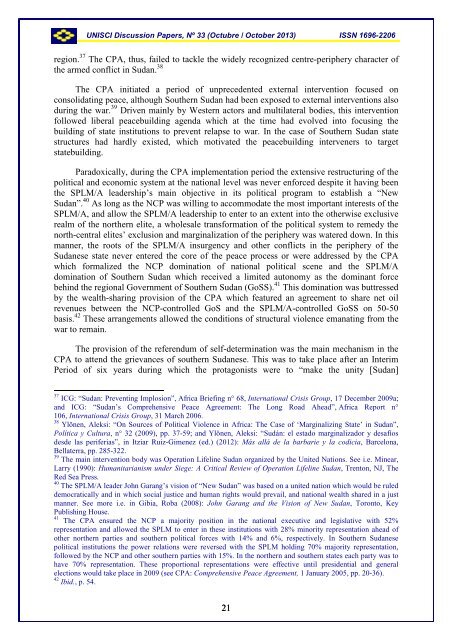UNISCI - Universidad Complutense de Madrid
UNISCI - Universidad Complutense de Madrid
UNISCI - Universidad Complutense de Madrid
Create successful ePaper yourself
Turn your PDF publications into a flip-book with our unique Google optimized e-Paper software.
<strong>UNISCI</strong> Discussion Papers, Nº 33 (Octubre / October 2013) ISSN 1696-2206region. 37 The CPA, thus, failed to tackle the wi<strong>de</strong>ly recognized centre-periphery character ofthe armed conflict in Sudan. 38The CPA initiated a period of unprece<strong>de</strong>nted external intervention focused onconsolidating peace, although Southern Sudan had been exposed to external interventions alsoduring the war. 39 Driven mainly by Western actors and multilateral bodies, this interventionfollowed liberal peacebuilding agenda which at the time had evolved into focusing thebuilding of state institutions to prevent relapse to war. In the case of Southern Sudan statestructures had hardly existed, which motivated the peacebuilding interveners to targetstatebuilding.Paradoxically, during the CPA implementation period the extensive restructuring of thepolitical and economic system at the national level was never enforced <strong>de</strong>spite it having beenthe SPLM/A lea<strong>de</strong>rship’s main objective in its political program to establish a “NewSudan”. 40 As long as the NCP was willing to accommodate the most important interests of theSPLM/A, and allow the SPLM/A lea<strong>de</strong>rship to enter to an extent into the otherwise exclusiverealm of the northern elite, a wholesale transformation of the political system to remedy thenorth-central elites’ exclusion and marginalization of the periphery was watered down. In thismanner, the roots of the SPLM/A insurgency and other conflicts in the periphery of theSudanese state never entered the core of the peace process or were addressed by the CPAwhich formalized the NCP domination of national political scene and the SPLM/Adomination of Southern Sudan which received a limited autonomy as the dominant forcebehind the regional Government of Southern Sudan (GoSS). 41 This domination was buttressedby the wealth-sharing provision of the CPA which featured an agreement to share net oilrevenues between the NCP-controlled GoS and the SPLM/A-controlled GoSS on 50-50basis. 42 These arrangements allowed the conditions of structural violence emanating from thewar to remain.The provision of the referendum of self-<strong>de</strong>termination was the main mechanism in theCPA to attend the grievances of southern Sudanese. This was to take place after an InterimPeriod of six years during which the protagonists were to “make the unity [Sudan]37 ICG: “Sudan: Preventing Implosion”, Africa Briefing n° 68, International Crisis Group, 17 December 2009a;and ICG: “Sudan’s Comprehensive Peace Agreement: The Long Road Ahead”, Africa Report n°106, International Crisis Group, 31 March 2006.38 Ylönen, Aleksi: “On Sources of Political Violence in Africa: The Case of ‘Marginalizing State’ in Sudan”,Política y Cultura, n° 32 (2009), pp. 37-59; and Ylönen, Aleksi: “Sudán: el estado marginalizador y <strong>de</strong>safíos<strong>de</strong>s<strong>de</strong> las periferias”, in Itziar Ruiz-Gimenez (ed.) (2012): Más allá <strong>de</strong> la barbarie y la codicia, Barcelona,Bellaterra, pp. 285-322.39 The main intervention body was Operation Lifeline Sudan organized by the United Nations. See i.e. Minear,Larry (1990): Humanitarianism un<strong>de</strong>r Siege: A Critical Review of Operation Lifeline Sudan, Trenton, NJ, TheRed Sea Press.40 The SPLM/A lea<strong>de</strong>r John Garang’s vision of “New Sudan” was based on a united nation which would be ruled<strong>de</strong>mocratically and in which social justice and human rights would prevail, and national wealth shared in a justmanner. See more i.e. in Gibia, Roba (2008): John Garang and the Vision of New Sudan, Toronto, KeyPublishing House.41 The CPA ensured the NCP a majority position in the national executive and legislative with 52%representation and allowed the SPLM to enter in these institutions with 28% minority representation ahead ofother northern parties and southern political forces with 14% and 6%, respectively. In Southern Sudanesepolitical institutions the power relations were reversed with the SPLM holding 70% majority representation,followed by the NCP and other southern parties with 15%. In the northern and southern states each party was tohave 70% representation. These proportional representations were effective until presi<strong>de</strong>ntial and generalelections would take place in 2009 (see CPA: Comprehensive Peace Agreement, 1 January 2005, pp. 20-36).42 Ibid., p. 54.21
















